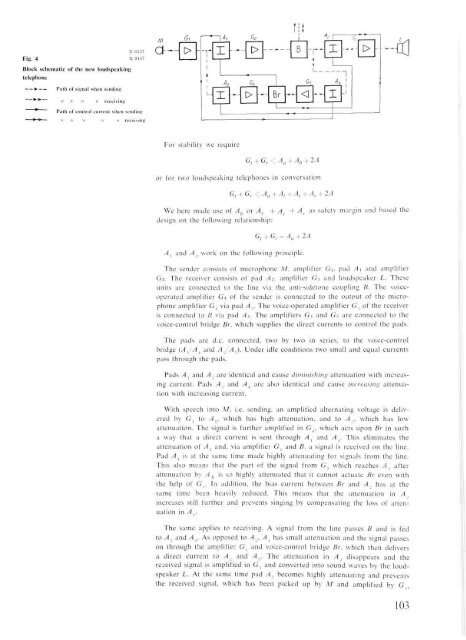1959 - History of Ericsson - History of Ericsson
1959 - History of Ericsson - History of Ericsson
1959 - History of Ericsson - History of Ericsson
You also want an ePaper? Increase the reach of your titles
YUMPU automatically turns print PDFs into web optimized ePapers that Google loves.
X 8157<br />
Fig. 4 X 9147<br />
Block schematic <strong>of</strong> the new loudspeaking<br />
telephone<br />
For stability we require<br />
or for two loudspeaking telephones in conversation<br />
We here made use <strong>of</strong> Ab or At + At + Ar as safety margin and based the<br />
design on the following relationship:<br />
A1 and A„ work on the following principle.<br />
The sender consists <strong>of</strong> microphone M, amplifier G\. pad A\ and amplifier<br />
Gi. The receiver consists <strong>of</strong> pad A*, amplifier Gi and loudspeaker L. These<br />
units are connected to the line via the anti-sidetone coupling B. The voiceoperated<br />
amplifier Gj <strong>of</strong> the sender is connected to the output <strong>of</strong> the microphone<br />
amplifier Gx via pad A3. The voice-operated amplifier G- <strong>of</strong> the receiver<br />
is connected to B via pad Ai. The amplifiers G\ and G.-, are connected to the<br />
voice-control bridge Br, which supplies the direct currents to control the pads.<br />
The pads are d.c. connected, two by two in series, to the voice-control<br />
bridge (A1/Ai and AJA.,). Under idle conditions two small and equal currents<br />
pass through the pads.<br />
Pads A} and A., are identical and cause diminishing attenuation with increasing<br />
current. Pads A., and At are also identical and cause increasing attenuation<br />
with increasing current.<br />
With speech into M, i.e. sending, an amplified alternating voltage is delivered<br />
by G, to Av which has high attenuation, and to A.,, which has lowattenuation.<br />
The signal is further amplified in G4, which acts upon Br in such<br />
a way that a direct current is sent through A1 and A4. This eliminates the<br />
attenuation <strong>of</strong> A^ and, via amplifier G , and B, a signal is received on the line.<br />
Pad At is at the same time made highly attenuating for signals from the line.<br />
This also means that the part <strong>of</strong> the signal from G., which reaches A ( after<br />
attenuation by A h is so highly attenuated that it cannot actuate Br even with<br />
the help <strong>of</strong> G.. In addition, the bias current between Br and A„ has at the<br />
same time been heavily reduced. This means that the attenuation in A„<br />
increases still further and prevents singing by compensating the loss <strong>of</strong> attenuation<br />
in /fr<br />
The same applies to receiving. A signal from the line passes B and is fed<br />
to A, and A4. As opposed to A.,, At has small attenuation and the signal passes<br />
on through the amplifier G. and voice-control bridge Br, which then delivers<br />
a direct current to A„ and As. The attenuation in A,, disappears and the<br />
received signal is amplified in G, and converted into sound waves by the loudspeaker<br />
L. At the same time pad A., becomes highly attenuating and prevents<br />
the received signal, which has been picked up by M and amplified by G<br />
103
















